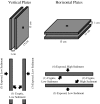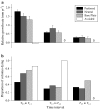Habitat selection, facilitation, and biotic settlement cues affect distribution and performance of coral recruits in French Polynesia
- PMID: 20169452
- PMCID: PMC2886133
- DOI: 10.1007/s00442-010-1578-4
Habitat selection, facilitation, and biotic settlement cues affect distribution and performance of coral recruits in French Polynesia
Abstract
Habitat selection can determine the distribution and performance of individuals if the precision with which sites are chosen corresponds with exposure to risks or resources. Contrastingly, facilitation can allow persistence of individuals arriving by chance and potentially maladapted to local abiotic conditions. For marine organisms, selection of a permanent attachment site at the end of their larval stage or the presence of a facilitator can be a critical determinant of recruitment success. In coral reef ecosystems, it is well known that settling planula larvae of reef-building corals use coarse environmental cues (i.e., light) for habitat selection. Although laboratory studies suggest that larvae can also use precise biotic cues produced by crustose coralline algae (CCA) to select attachment sites, the ecological consequences of biotic cues for corals are poorly understood in situ. In a field experiment exploring the relative importance of biotic cues and variability in habitat quality to recruitment of hard corals, pocilloporid and acroporid corals recruited more frequently to one species of CCA, Titanoderma prototypum, and significantly less so to other species of CCA; these results are consistent with laboratory assays from other studies. The provision of the biotic cue accurately predicted coral recruitment rates across habitats of varying quality. At the scale of CCA, corals attached to the "preferred" CCA experienced increased survivorship while recruits attached elsewhere had lower colony growth and survivorship. For reef-building corals, the behavioral selection of habitat using chemical cues both reduces the risk of incidental mortality and indicates the presence of a facilitator.
Figures




Similar articles
-
Coral larval settlement preferences linked to crustose coralline algae with distinct chemical and microbial signatures.Sci Rep. 2021 Jul 16;11(1):14610. doi: 10.1038/s41598-021-94096-6. Sci Rep. 2021. PMID: 34272460 Free PMC article.
-
Boat noise prevents soundscape-based habitat selection by coral planulae.Sci Rep. 2018 Jun 18;8(1):9283. doi: 10.1038/s41598-018-27674-w. Sci Rep. 2018. PMID: 29915303 Free PMC article.
-
Hierarchical settlement behaviours of coral larvae to common coralline algae.Sci Rep. 2023 Apr 9;13(1):5795. doi: 10.1038/s41598-023-32676-4. Sci Rep. 2023. PMID: 37032381 Free PMC article.
-
Environmental impacts of dredging and other sediment disturbances on corals: a review.Mar Pollut Bull. 2012 Sep;64(9):1737-65. doi: 10.1016/j.marpolbul.2012.05.008. Epub 2012 Jun 7. Mar Pollut Bull. 2012. PMID: 22682583 Review.
-
Biological and remote sensing perspectives of pigmentation in coral reef organisms.Adv Mar Biol. 2002;43:277-317. doi: 10.1016/s0065-2881(02)43006-4. Adv Mar Biol. 2002. PMID: 12154614 Review.
Cited by
-
Microbial to reef scale interactions between the reef-building coral Montastraea annularis and benthic algae.Proc Biol Sci. 2012 Apr 22;279(1733):1655-64. doi: 10.1098/rspb.2011.2155. Epub 2011 Nov 16. Proc Biol Sci. 2012. PMID: 22090385 Free PMC article.
-
Rapid multi-generational acclimation of coralline algal reproductive structures to ocean acidification.Proc Biol Sci. 2021 May 12;288(1950):20210130. doi: 10.1098/rspb.2021.0130. Epub 2021 May 12. Proc Biol Sci. 2021. PMID: 33975470 Free PMC article.
-
Ocean warming and acidification have complex interactive effects on the dynamics of a marine fungal disease.Proc Biol Sci. 2014 Jan 22;281(1778):20133069. doi: 10.1098/rspb.2013.3069. Print 2014 Mar 7. Proc Biol Sci. 2014. PMID: 24452029 Free PMC article.
-
Larval precompetency and settlement behaviour in 25 Indo-Pacific coral species.Commun Biol. 2024 Jan 31;7(1):142. doi: 10.1038/s42003-024-05824-3. Commun Biol. 2024. PMID: 38297134 Free PMC article.
-
Multiscale variability in coral recruitment in the Mascarene Islands: From centimetric to geographical scale.PLoS One. 2019 Mar 22;14(3):e0214163. doi: 10.1371/journal.pone.0214163. eCollection 2019. PLoS One. 2019. PMID: 30901355 Free PMC article.
References
-
- Babcock R, Mundy C. Coral recruitment: consequences of settlement choice for early growth and survivorship in two scleractinians. J Exp Mar Biol Ecol. 1996;206:179–201. doi: 10.1016/S0022-0981(96)02622-6. - DOI
-
- Babcock RC, Baird AH, Piromvaragorn S, Thomson DP, Willis BL. Identification of scleractinian coral recruits from Indo-Pacific reefs. Zool Stud. 2003;42:211–226.
-
- Baird AH, Morse ANC. Induction of metamorphosis in larvae of the brooding corals Acropora palifera and Stylophora pistillata. Mar Freshwater Res. 2004;55:469–472. doi: 10.1071/MF03121. - DOI
-
- Becerro MA, Bonito V, Paul VJ. Effects of monsoon-driven wave action on coral reefs of Guam and implications for coral recruitment. Coral Reefs. 2006;25:193–199. doi: 10.1007/s00338-005-0080-7. - DOI
-
- Bertness MD. Interspecific interactions among high marsh perennials in a New England salt marsh. Ecology. 1991;72:125–137. doi: 10.2307/1938908. - DOI

